Famous for being the world’s largest land animal migration, Africa’s great wildebeest migration takes place each year in Tanzania and Kenya.
*This post may contain affiliate links, as a result, we may receive a small commission (at no extra cost to you) on any bookings/purchases you make through the links in this post. As an Amazon Associate, we earn from qualifying purchases. Read our full disclosure
Adventurous travellers from around the globe flock to the Masai Mara and Tanzania’s Serengeti National Park in hopes of seeing the dramatic scenes that this journey provides.
For us, a chance to witness the wildebeest migration was an opportunity of a lifetime. When we found out that we would be heading out on a Serengeti safari at the right time to catch the Wildebeest Migration, we were beyond excited!
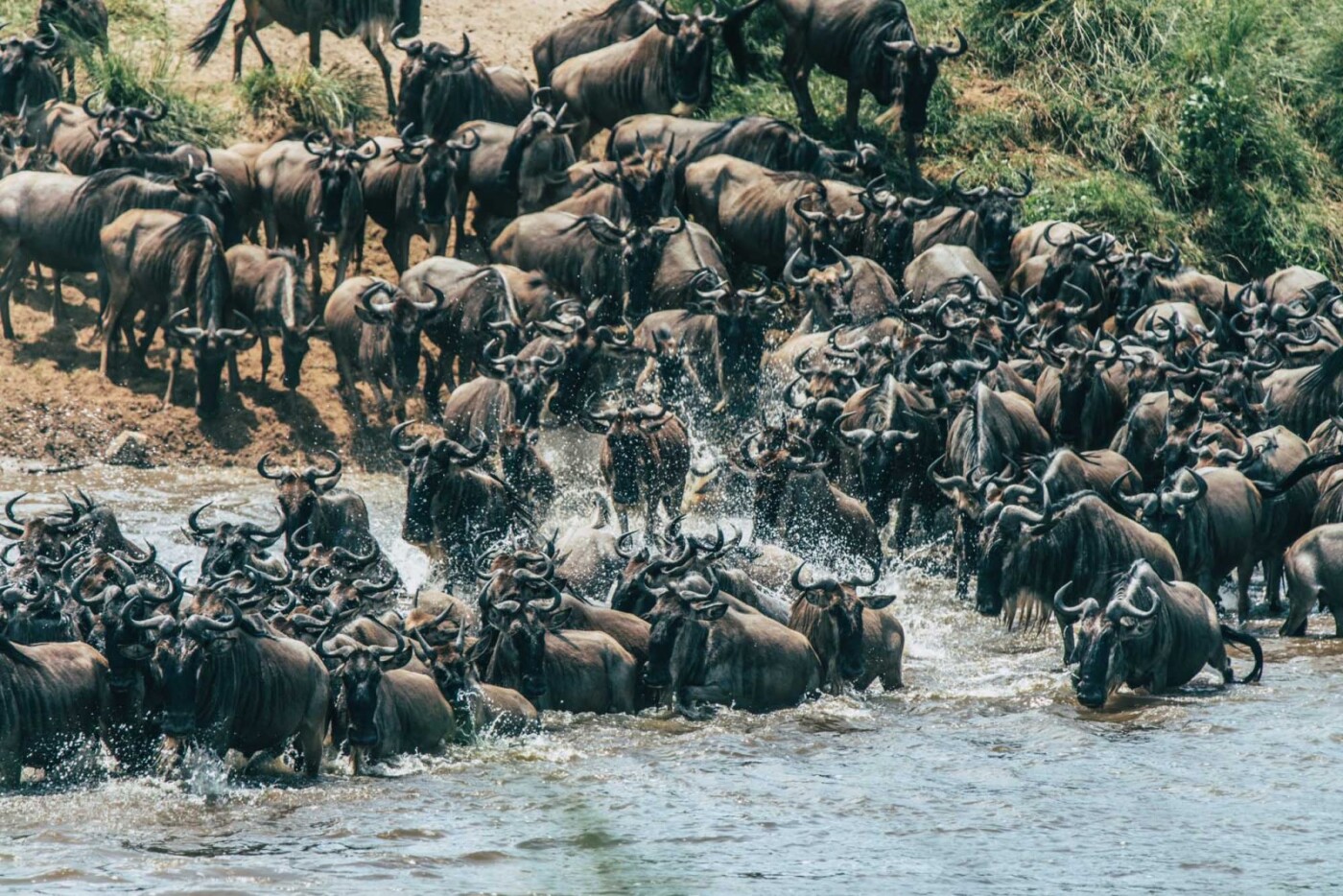
Traveling Soon? Here is a list of our favourite travel providers and accessories to help get you ready for your upcoming trip!
What Is The Wildebeest Migration In The Serengeti?
The great migration is a 1000 km(621 miles) circular journey undertaken by wildebeest herds in the Great Rift Valley of Kenya and Tanzania.
The cause of the migration is somewhat of a mystery, but scientists do know that the wildebeest are in constant search of fresh lands to graze on, which contributes to their urges to migrate. Regardless of their reasons, every year, like clockwork, the wildebeests complete a perilous circumnavigation of some of Africa’s most stunning natural landscapes.
The Highlight Of The Great Migration In Africa Is The Mara River Crossing Which Separates Kenya From Tanzania.
Wildebeest herds must cross this river twice along the journey. Although, as it turns out, the wildebeest often cross the river more often than that!
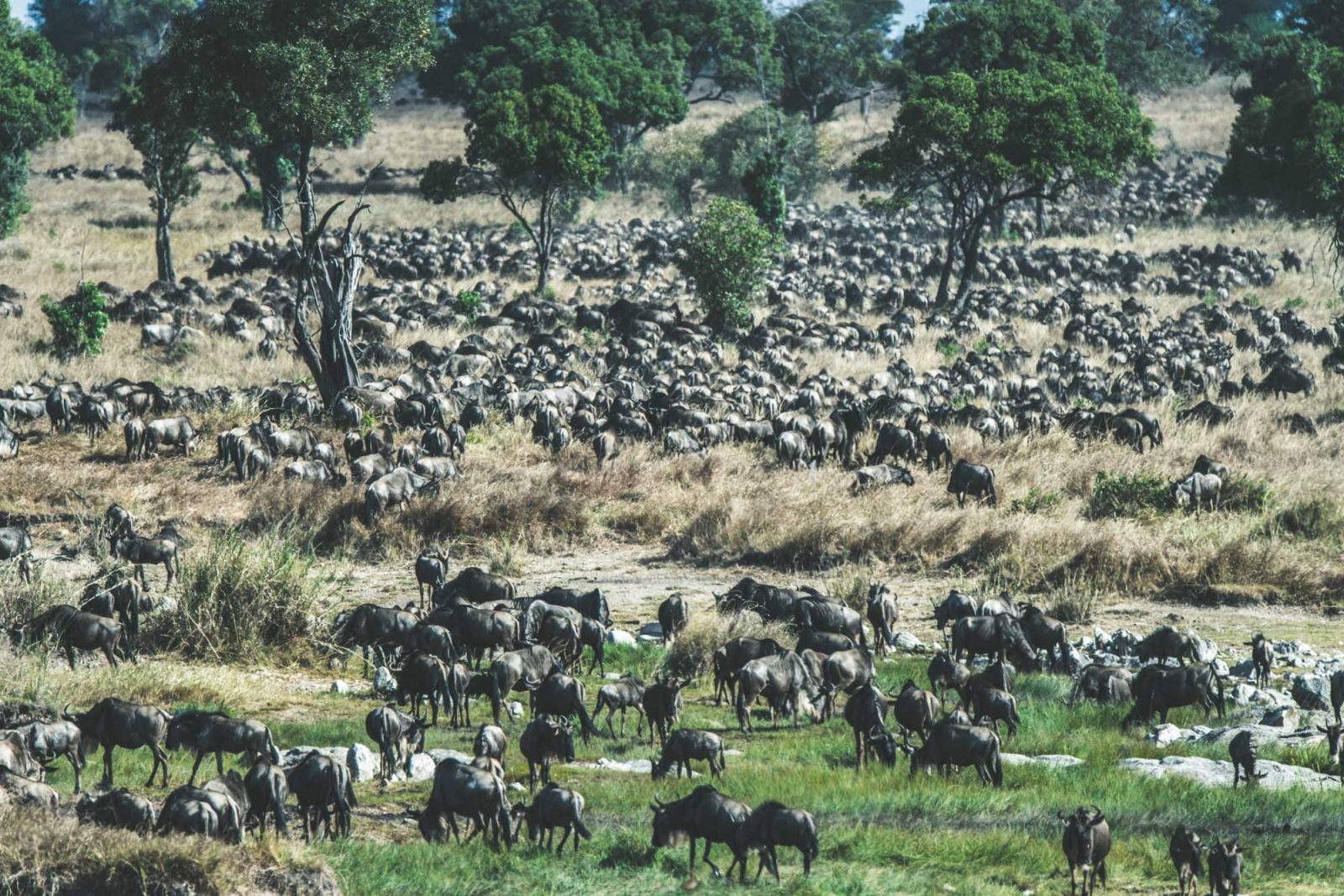
Best Time To Witness The Great Migration, Africa
While this natural phenomenon is world-famous, most people don’t realize just how fleeting the main highlights can be. Timing your trip can be challenging when expectations are high especially when you are counting on nature to put on a show.
Cooperation is not guaranteed, but by being aware of the timeline of the migration, you can maximize your chances of seeing the main draw – the famous river crossings.

Serengeti Migration Timeline
Over 1.5 million wildebeest migrate over the same path each and every year, travelling clockwise in an enormous loop.
The journey has, in essence, no true beginning, middle, or end. However, the stages of the migration are quite distinct, and it is important to understand how the migration works before setting out to see it yourself.
Also, it is important to note that while they follow the same general migration route each year, wildebeest migrate in huge numbers and are not always running on the exact schedule they might have had in previous years.
Their timelines vary somewhat from year to year, and their routes may deviate slightly as well. To combat this challenge, use HerdTracker, a program run by DiscoverAfrica.com that provides frequently updated information on the wildebeest’s whereabouts.
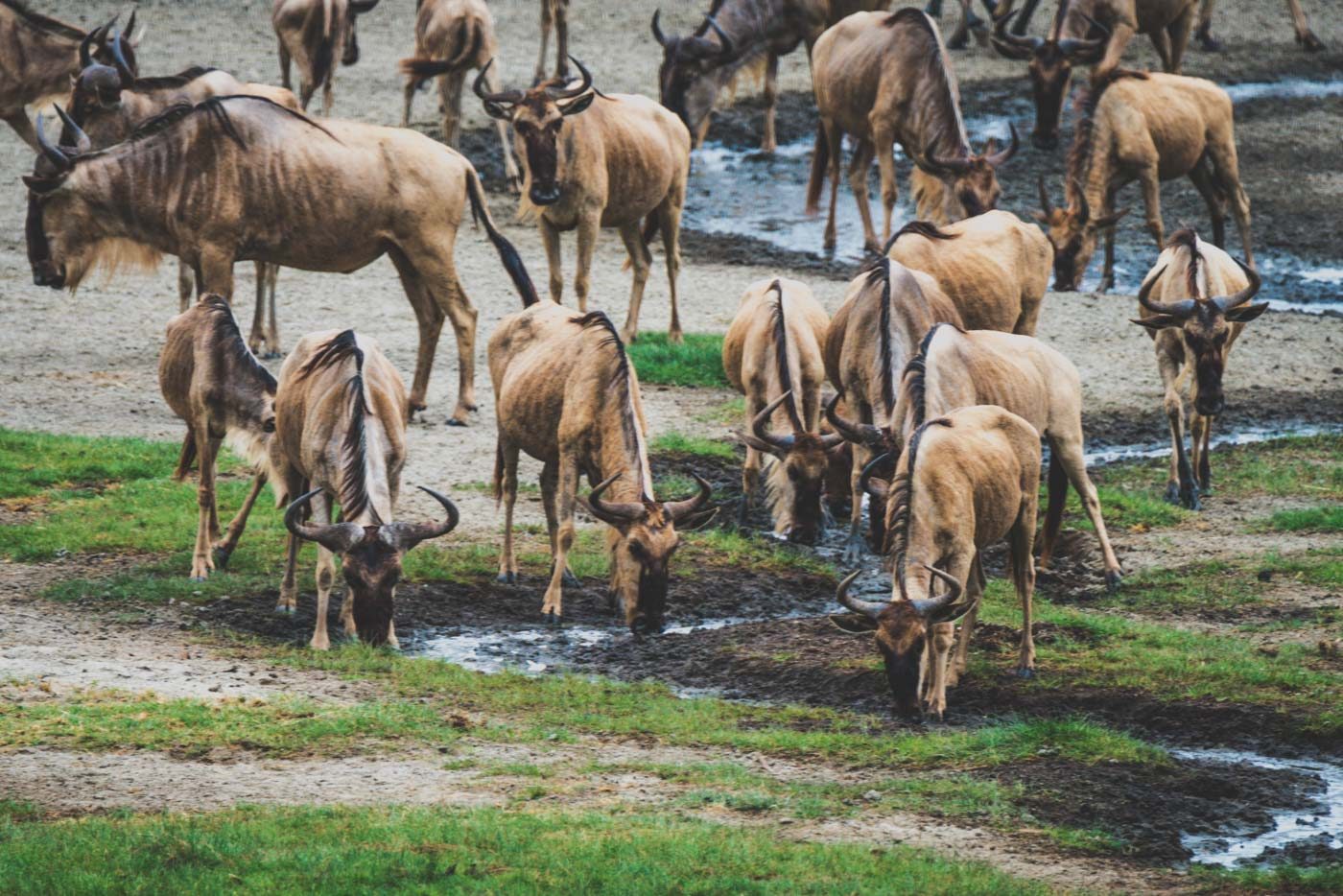
Calving Season (January to March) – Southern Serengeti
wildebeest give birth to their young on the plains of the southern Serengeti and in the Ngorongoro Conservation Area. The baby wildebeest grow up fast and are able to run at full speed only a few weeks after they are born, an essential survival skill for the journey to come.
When the wildebeest elders sense that it is time to start moving, the entire herd follows suit and begins moving north through the grass plains to begin their annual Serengeti Migration.
Northern Movement (March to August) – Central to Northern Serengeti
As the wildebeest move north through the Serengeti and the Maswa Game Reserve, they are also accompanied by large herds of zebras. Together, they travel for months, fighting hunger, disease, and exhaustion along the way. As they tire, they become easier prey for their predators. Thousands of animals never make it through this part of the Serengeti migration.
River Crossings (August to November) – Mara River Crossings
For most travellers, the river crossings are the main draw of the wildebeest migration.
The Mara River, located in the northern Serengeti and Masai Mara, is the most famous and popular river crossing among tourists. The Masai Mara migration sees wildebeest crossing the crocodile-infested river heading north to enter the Masai Mara National Reserve.
Once there, they relax only briefly before crossing the river once again, this time to head south. The northbound crossing takes place in August and September, and the southbound crossing occurs in October and November.
The Mara River Crossings Are The Most Exciting And Action-Packed Portions Of The Great Migration.
Africa has few greater draws, so if you are planning on seeing just one part of the wildebeest migration, make it this one.
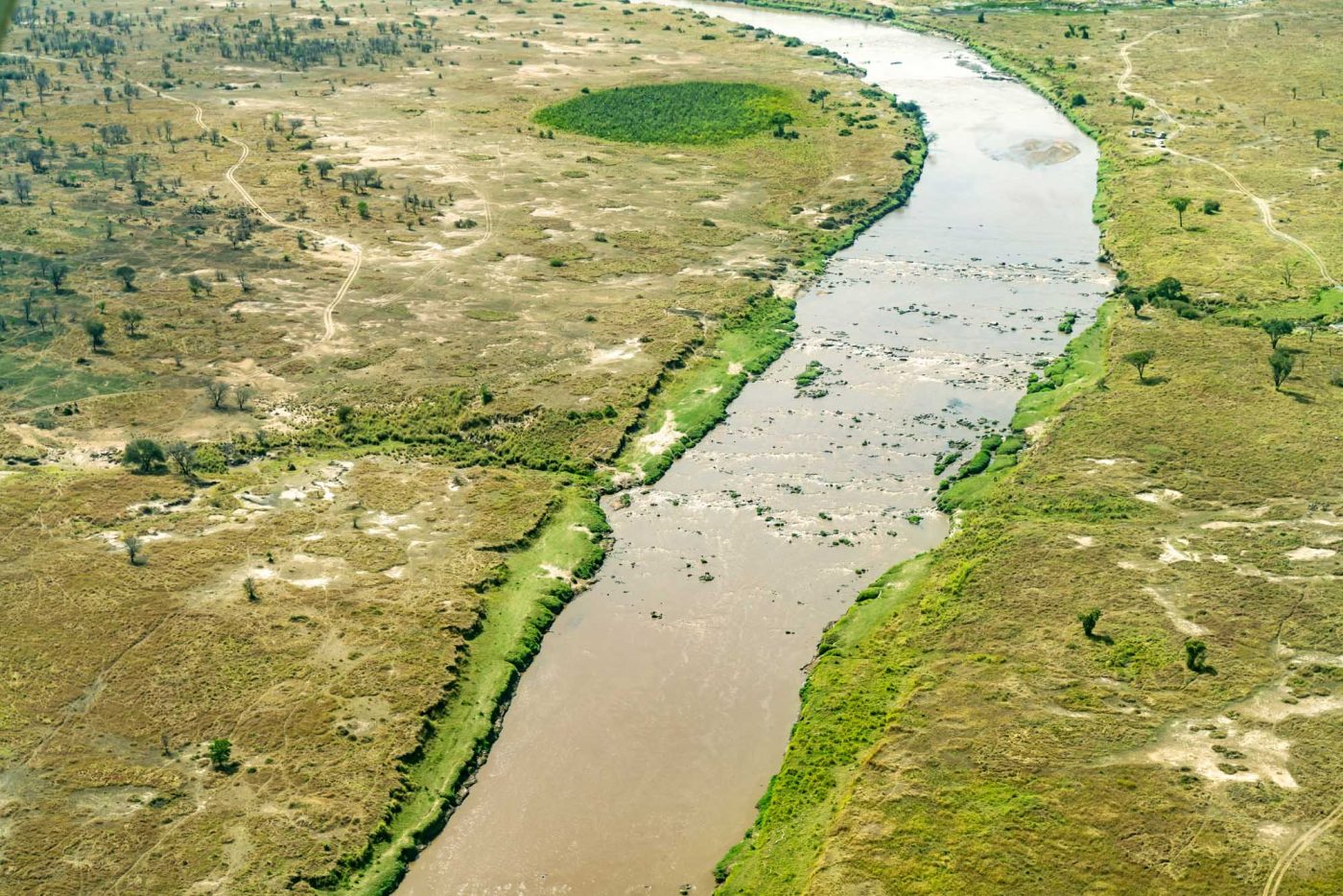
Southern Movement (November to January) – Central to Southern Serengeti
After finally putting the rivers behind them, the wildebeest travel south through the Serengeti towards the Ngorongoro Conservation Area, where they will once again stay to birth their young in the coming months.
What It’s Like To Witness The Wildebeest Migration
While nature documentary films might have prepared you for some intense action during your trip, what you might not realize is that Wildebeest Migration River Crossings are relatively infrequent events.
The great migration in Africa is a journey of a thousand kilometres, and the river crossings are only a small part of it. You may need to wait two or more days to see a river crossing, and it requires a great deal of patience.
You’ll be sitting around a lot and waiting for hours on end. However, those who wait will be rewarded with the incredible sight of a Masai Mara migration.
It’s important to understand that the 2 million wildebeest that participate in the Great Migration journey across the plains in smaller herds ranging in size from 1000-50,000 on a yearly basis.
The Mara River, which separates Tanzania and Kenya and keeps the wildebeest from greener pastures, stretches for nearly 400 km(248 miles) and offers the wildebeest a number of great crossing points. Ideal crossings, those with banks that offer a path to the river bed, are usually found every 500 m to 800 m along the river banks.
When a particular herd of wildebeest arrive at the banks of the river, they search for a place where the banks are not too steep.
It may take hours for them to amass the courage to take the first step into the river. Many will hover right on the edge of the river bank for hours, teasing the nearby onlookers with one of the greatest wildlife shows on the planet.
While the wildebeest hesitate, the dozens of safari jeeps that gather daily to observe the crossings must sit back, staying out of sight of the animals so as to not spook them with the sounds of engines, windshield reflections, and other distractions.
Eventually, if the rules of the game are adhered to, one of the wildebeest will take the first brave leap across the river to indicate the start of yet another wildebeest crossing. The rest of the wildebeest will follow.


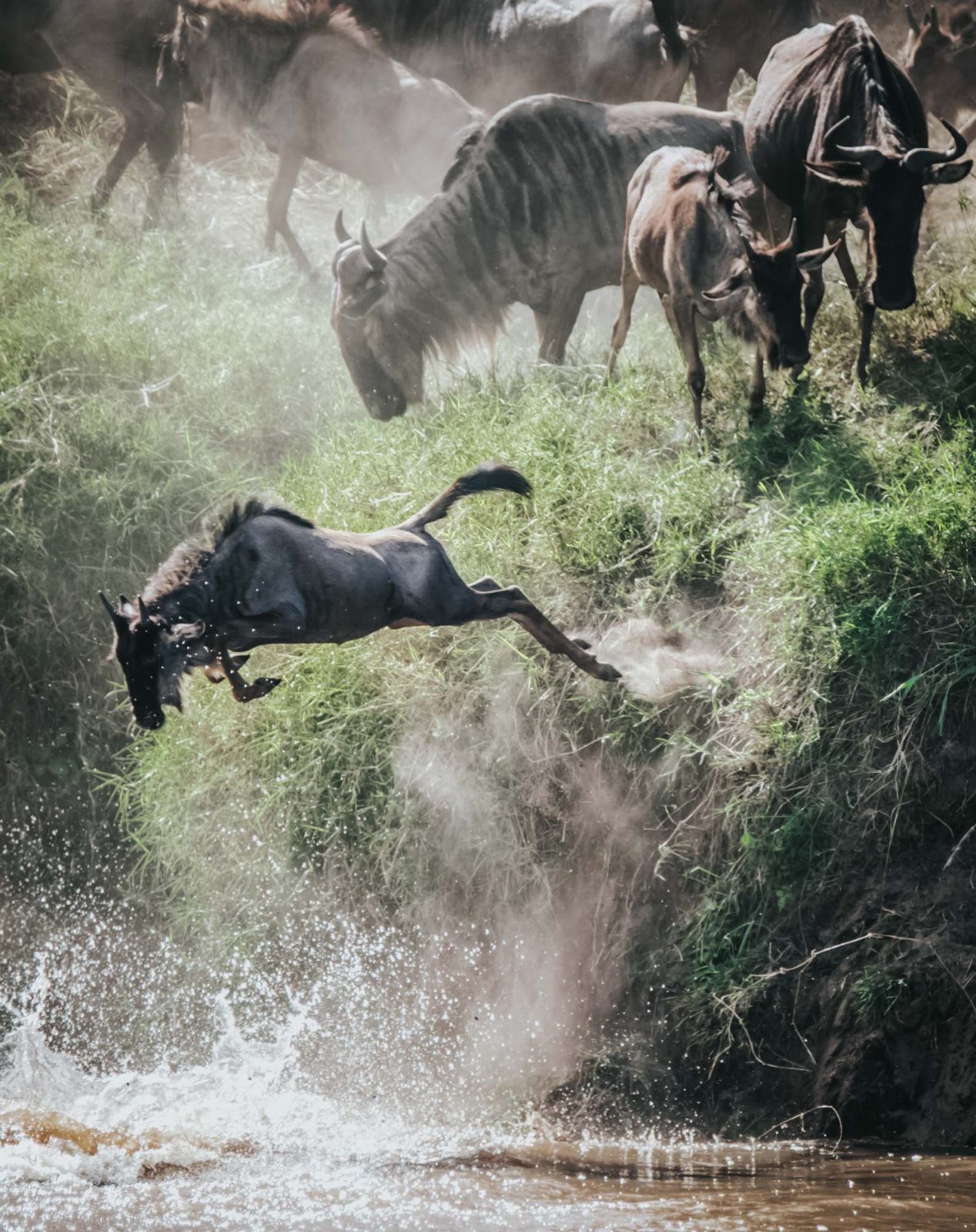

It is only when the wildebeest give their undivided attention to the crossing and tune out everything else going on around them that the safari vehicles are allowed to move in close to catch a better view of the greatest animal migration in Africa.
When The Moment Arrives, Be Prepared: The Vehicles Will Rev Their Engines And Race To The Front, Fighting To Score The Best Viewing Spot Along The River Bank.
The crossings themselves tend to be short, lasting between two and twenty minutes. (After all, the rivers are infested with crocodiles, and you can’t blame them for wanting to make it quick!) Because of this, also be prepared for more than one grizzly scene if the crocodiles have successful hunts.
How To Maximize Your Trip To The Great Migration, Serengeti
Select Your Accommodations Carefully
Planning a safari in the Serengeti is quite an undertaking, and planning one to coincide with the great migration in the Serengeti is an even bigger feat!
When visiting the Serengeti during the wildebeest migration, it is important to thoroughly research your accommodations ahead of time. For the best chances of catching a wildebeest river crossing, you’ll want to find a safari camp that meets the following criteria.
Mobile Safari Camp
While there is no shortage of fantastic, responsible safari lodges in the Serengeti, you’ll want to make sure yours is a mobile camp. These have the ability to pick up and move wherever the wildebeest is most prominent. This will be a great advantage, especially if nature decides to be unpredictable, as it often does.
During our safari in the Serengeti, we stayed at the Lemala Mara Camp, a camp that moves with the seasons to follow the wildebeest in their migration path. This tented camp moves north through the Serengeti between the months of June and October, and the precise locations vary from year to year. They try to get close to the river without disturbing the wildlife or disrupting the migration pattern.
Lemala Mara has just 12 tent accommodations, and the tents are spacious and comfortable. There is an ensuite bathroom with a flush toilet and hot safari-style shower, and there are limited laundry services. Lemala is focused on providing authentic experiences while implementing sustainable practices, and the camp is 100% reliant on solar electricity, with a backup generator if needed.
We visited in October when the camp was located near Crossing #4 and were lucky enough to spot multiple crossings right in front of our camp.

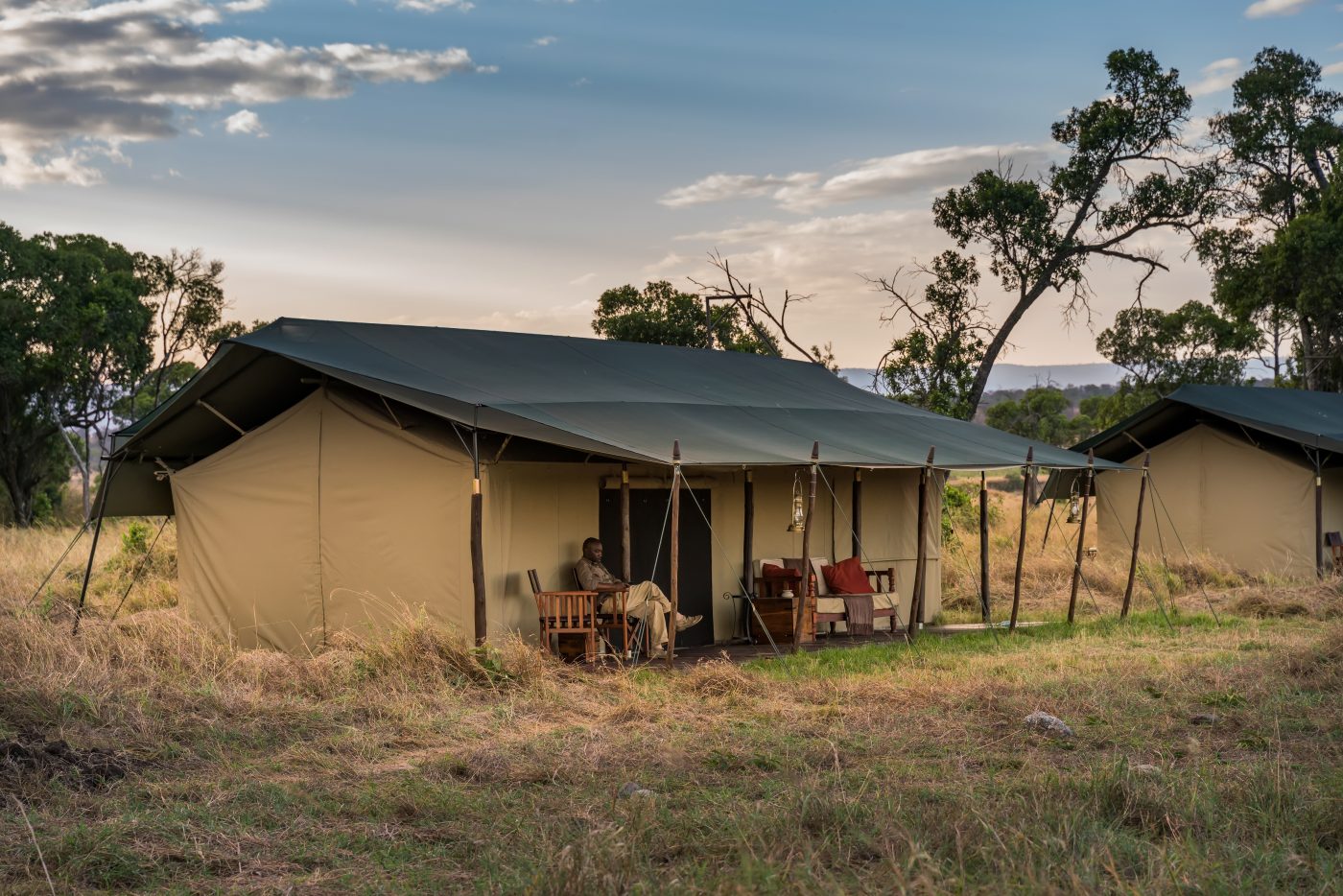
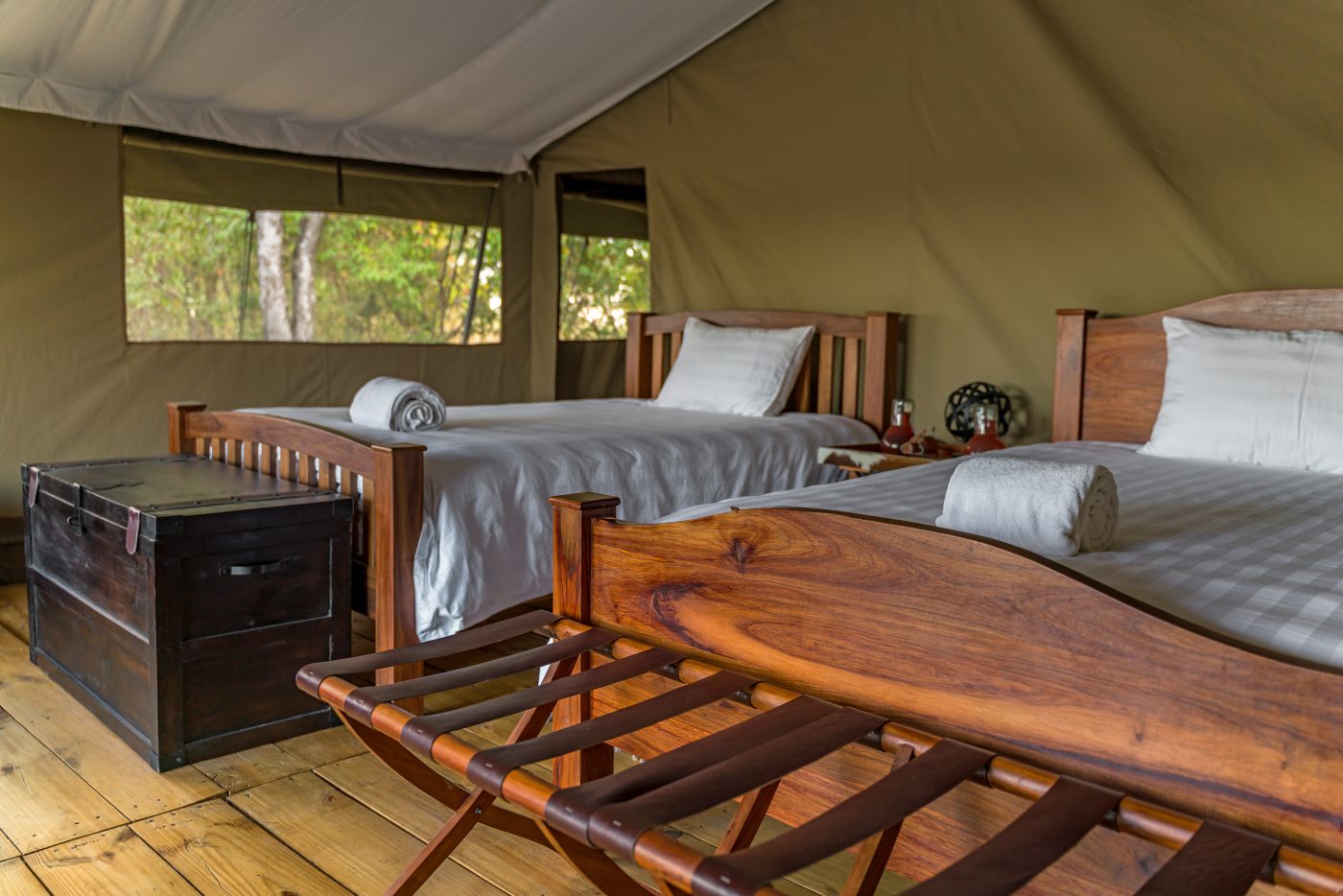
Permanent Lodge
If you prefer the comfort and safety of an established lodge, there are plenty of amazing eco-lodges in the Serengeti. The Four Seasons Serengeti Lodge offers a luxurious experience with all amenities and comforts. The lodge itself is isolated, surrounded by savannah and its infinity pool overlooks a waterhole that attracts elephants and other wildlife.
The lodge also arranges excursions, including game drives, trips to local Maasai villages, and safaris that seek out the Great Migration. While you might have a better chance of seeing the wildebeest migration from a mobile safari camp, there is plenty more to see and do in the Serengeti National Park.
Located Close to the River
It’s important to make sure that your camp is located close to the Mara River so you can have easy access to all the action (or return quickly if need be.) In addition, you should ask ahead of time which river crossing points your camp is near. There are many known crossing spots along the length of the river, and most are used in some months more than others. In addition, the crossings are generally spread out, so travelling from one to another could take up to an hour and could cause you to miss the wildebeest river crossing while in transit.
Hire A Local Guide
Not only is hiring a local guide a great way to be a sustainable traveller and support the local economy, but the truth is that no one knows more than the locals when it comes to the unspoken rules of following the wildebeest migration in the Serengeti.
It was our local Lemala guide Frank, who helped us understand the intricacies of the wildebeest migration crossings and helped us maximize our chances of spotting one.
Frank knew exactly where to park our safari vehicle while we patiently waited for herds to choose crossing points.
He knew exactly when to turn on the engine and drive madly towards the river when the crossing commenced, always positioning us with a perfect angle for fantastic photo ops of the crossing.


Plan To Be Patient
As previously mentioned, the wildebeest migration is a long event, and the river crossings are a fast and fleeting part of it. It will require a lot of patience should you truly want to witness one. You might sit and wait for an entire day without any reward. With this in mind, make a plan for how you will pass the time when you’re waiting for the action to start.
This is the perfect opportunity to catch up on some reading or get to know your local guide. Pack food, books, games, and a sense of humour to help keep your morale high when nature is not cooperating.
Have Other Activities Planned
Make the most of your time in this amazing part of the world by adding other destinations to your itinerary. There is plenty more wildlife to see, beautiful beaches to relax on, and stunning landscapes to explore. If you have the time, consider combining a trip to some of these destinations with your Great Migration Safari.
Take a trip to South Africa. There are so many beautiful sights in South Africa, and cities like Cape Town and Durban are known for their diverse culture and vibrant art scenes. Consider jumping on a flight to South Africa and then taking a road trip to see more of the natural beauty this country is famous for.
See the sights in Kenya. Much closer to the Serengeti than South Africa, Kenya is full of attractions, and you can watch the wildebeest migration here, too! Maasai Mara National Reserve is the place to go to see the Great Migration, plus other species like the Big Five can be seen here as well.
Visit the famous Victoria Falls. This iconic waterfall is a bit far from Serengeti, but if you don’t mind hopping on a short flight, it’s worth it. You can easily spend a few days in Victoria Falls, as there is so much to do and see here. You can swim in the Devil’s Pool (during dry season), go on a river safari, hike through Victoria Falls National Park, and so much more.

How to get to Northern Serengeti
Getting to the northern Serengeti to witness the Great Migration can be a thrilling experience. The northern part of the Serengeti is a prime location for seeing the wildebeest migration between July and August. To get there, follow these steps:
Fly into Tanzania
Start by booking a flight to either Kilimanjaro International Airport (JRO) or Julius Nyerere International Airport (DAR) in Tanzania, depending on your travel plans and itinerary. Kilimanjaro Airport is closer to the northern Serengeti.
Book a Domestic Flight:
From JRO or DAR, you’ll need to book a domestic flight to one of the airstrips in the northern Serengeti. The two most common airstrips for reaching the northern Serengeti are Kogatende Airstrip and Lamai Airstrip. It’s recommended to book this domestic flight in advance.
RED NEXT: How to Plan a Responsible Safari Tour in the Serengeti
What do airlines fly to Northern Serengeti?
Coastal Aviation is a regional airline that offers scheduled flights to various airstrips in the Serengeti, including Kogatende Airstrip. They have a good track record for serving the northern Serengeti.
Auric Air is another regional airline in Tanzania known for connecting travellers to different airstrips within the country. They also offer flights to Kogatende Airstrip.
Safari Air Link is a smaller airline that specializes in connecting tourists to wildlife destinations in Tanzania, including the northern Serengeti.
Coastal Aviation and Auric Air Charter Flights offer charter flight services to the northern Serengeti. Charter flights can be arranged for more flexibility in terms of timing and destination.

What To Pack
Packing for any safari can be a daunting task that requires a bit more effort than other trips might. Above all, we recommend investing in quality clothing and gear that will be able to weather the elements and last for a long time.
Make sure to pack earth-toned clothing, sturdy shoes, and a good hat. You may want to pack a couple of layers for cooler evenings as well. A first aid kit is highly recommended.
As far as gear goes, you’ll definitely want to bring along a pair of binoculars. You’ll be viewing the wildebeest from a distance, and you’ll find binoculars truly invaluable.
If You’re A Photographer, Make Sure To Pack A Telephoto Lens And A Great Camera.
These will be essential for catching the once-in-a-lifetime action from a distance. It will also be helpful to bring good cases, and dust covers to protect your gear. If you’re travelling with a lot of electronics, bring a power strip for charging everything. Also, don’t forget a flashlight or headlamp.

How Much Time To Spend Watching The Wildebeest Migration
As our Lemala guide reminded us day in and day out, the Serengeti is not a zoo. It’s unpredictable and unreliable, and a daily crossing is not a guaranteed occurrence.
We saw dozens of fellow travellers book the Lemala Mara Camp for a two-night stay and end up leaving three days later without seeing a single crossing. They weren’t patient enough, they didn’t pick the right crossings, or they were simply unlucky.
In order to maximize your chances of seeing the crossings, we recommend that you plan to spend at least three to four nights in the Northern Serengeti during the key Mara River Crossing time frame.
If you are really serious about seeing a wildebeest crossing, pack a lunch and plan to spend your entire day out by the river to maximize your chance of catching the crossing.
We were incredibly lucky during our visit and were able to spot not one, not two, but six (6!!!) different crossings during our four days in the Northern Serengeti, and we absolutely loved our experience. We found each crossing to be a little bit different and unique in its own way, offering plenty of excitement!
The great migration, Serengeti, is truly the trip of a lifetime, but it certainly requires an above-average plan to really make the most of it. We do hope this guide helps you to plan an unforgettable trip to the greatest animal migration Africa has to offer.
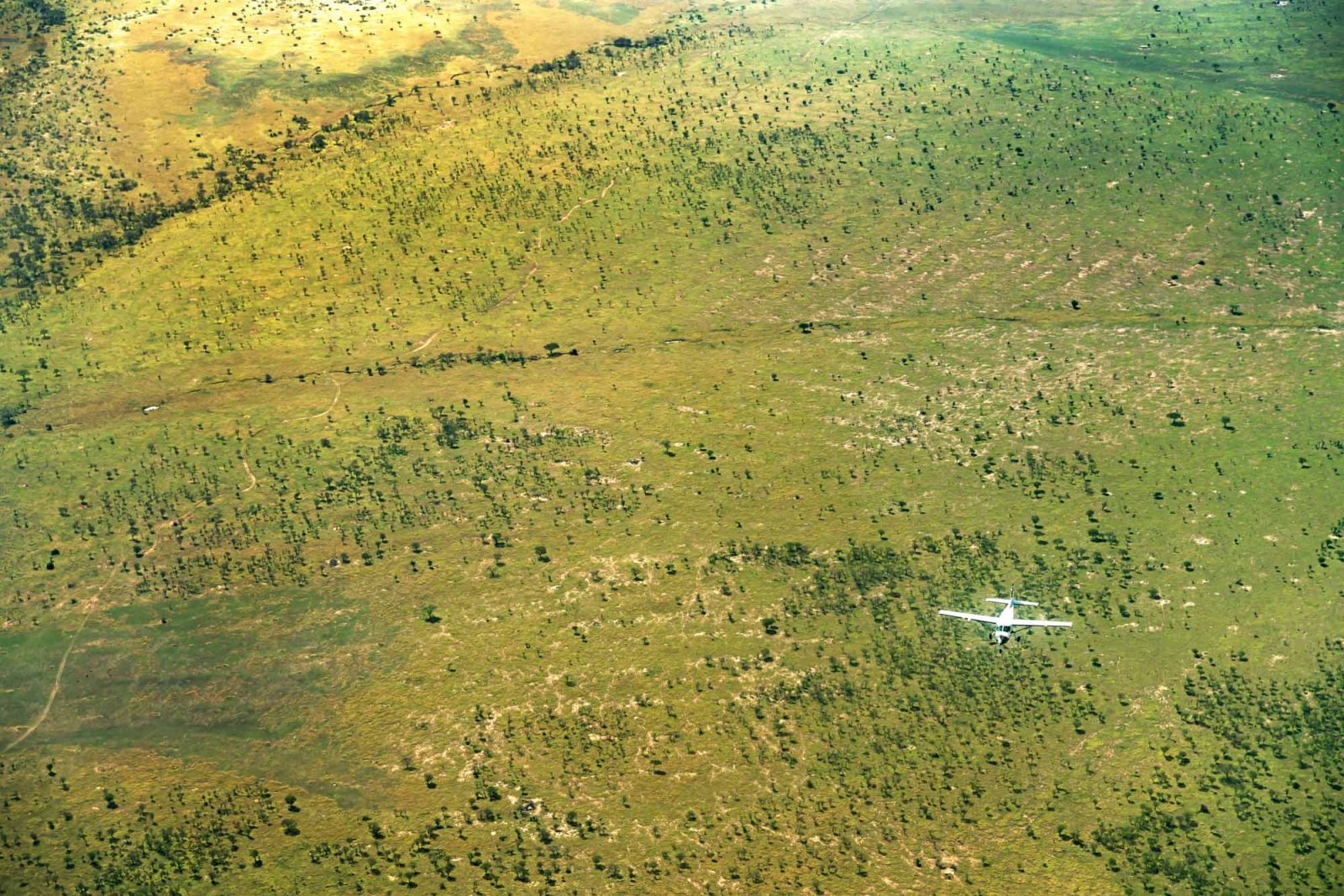
Have You Ever Seen a Wildebeest On Safari? Share Your Wildebeest Encounters Below!

